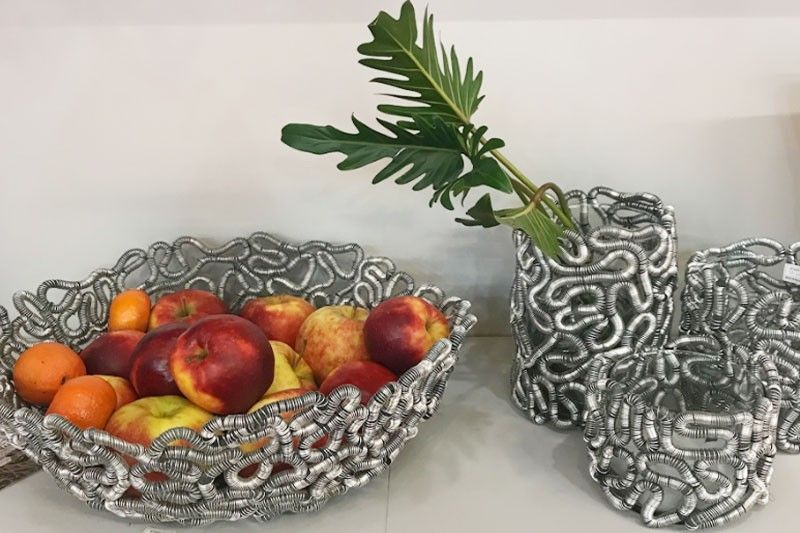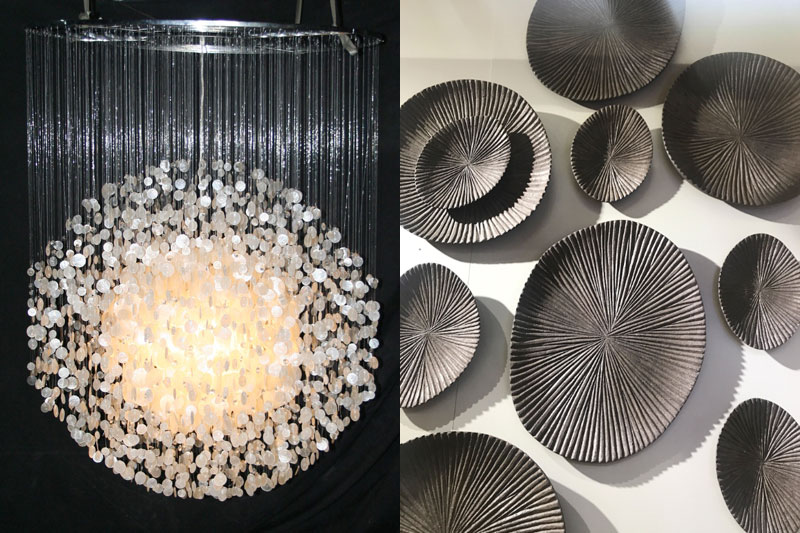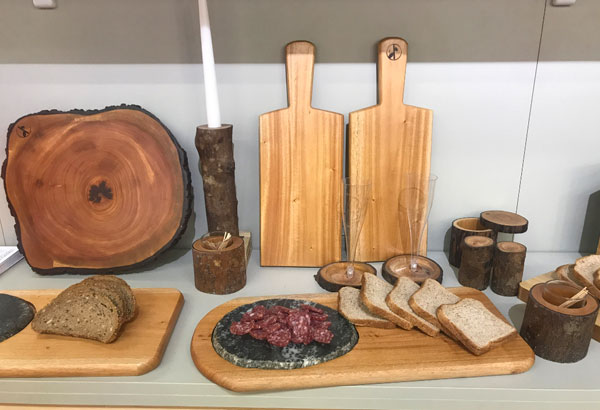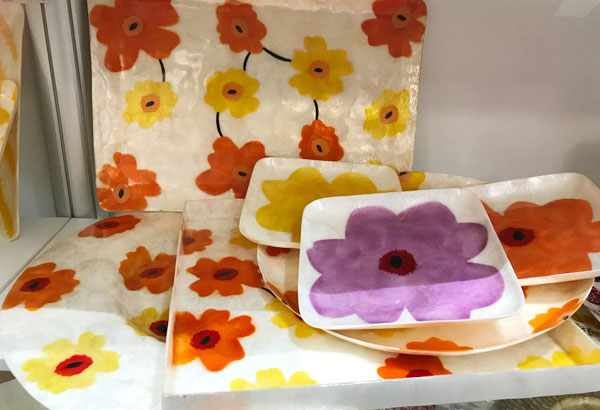Philippine products on trend at Ambiente


Tadeco containers, made from the country’s largest banana and abaca plantations
Ambiente, the world’s largest consumer goods fair whose exhibition grounds are the size of 43 football fields, is also a design writer’s playground. Held recently in Frankfurt, Germany, it featured 4,441 exhibitors from 89 countries, and 134,600 buyers from 168 countries, making it the most international edition.
Some of the most interesting designs we saw this year were wall accents: one shaped like brain corals made of abaca wrapped with wire, another made of recycled election tarpaulins, black decorative accents made from banana wood, and vintage-shaped chairs made modern with traditional rattan weaving.
And these are just a few from Philippine manufacturers in Hall 10, the section where wholesalers and importers go.
“We-Link has continuously built Brand Philippines all over the world by bringing our manufacturers to major trade fairs to showcase the Filipino talent. Each piece exhibited at Ambiente shows the flair of our designers and manufacturers, and we are very be proud of them,” says Wilbert Novero, general manager of We-Link.
Worldwide Exhibitions Linkage Services (We-Link), a division of Global-Link Exhibitions Specialist Inc. (Global-Link ESI) and the official sales and marketing partner of Messe Frankfurt in the Philippines, provides support to independent exhibitors from the Philippines.

(Left)Shell Arts’ capiz chandelier, in black and natural color, always stops visitors in their tracks. (Right) Nature’s Legacy uses Stonecast, Marmorcast, and Moltencast among other sustainable materials.
Along with them were those supported by CITEM’s Lifestyle Philippines with Tony Gonzales as design director and Tes Pasola as onsite curator. All in all, almost 40 exhibitors represented the country’s manufacturers.
Looking at their products, it was obvious that they nailed the trends identified by Bora.herke.palmisano Trend Bureau, which does the research and curatorial work for Ambiente Trends. They came up with the trends by taking cues from relevant influences in design, art, architecture, fashion and lifestyle.
Bora.herke.palmisano Trend Bureau created vignettes as examples of the four stylistic directions, namely, Modest Regenerations, Colorful Intentions, Technological Emotions and Opulent Narrations.
Some of the key words in the report are “country house,” “recycling and upcycling,” “sustainable,” “rich in allusions,” and “innovative visual accents.” Preferred materials include wood, stone, ceramics, cast iron, recycled plastic and embroidery.
The trends forecasters might as well have been describing design and products from the Philippines. Take Artisana Island Crafts’ wall and tabletop accessories and lamps. They are made from recycled election tarpaulins from 2016.

Silay Export managing director Reena Gamboa-Peña
Who would have thought that upcycling them would also be doing the country a service by getting rid of those ugly pollutants on our streets and highways?
“These are things that would have filled our landfills,” says Mary Ann F. Colmenares of the Bacolod-based Artisana Island Crafts. “You can see from what party the tarp is from the colors of the finished products. It’s our first time to use this material and design a whole collection.”
The tarps are woven flat so that they can be manipulated into any shape. There’s a particular thickness Mary Ann is looking for because too thick would mean it cannot be woven well and too thin wouldn’t hold its shape.
How do people react when she tells them what they are made of? “They’re very receptive and aliw with it. They like the design in the first place and like it even more when we tell them the story.”
Another story worth retelling is Tadeco Home, which is part of Tagum Agricultural Development Company Inc. (Tadeco), one of the highest yielding banana plantations in the world and employing about 10,000 people.

Kitchen accessories made from Honduran mahogany by Marsse Tropical Timber Plantations
Tadeco Home creative director Maricris Floirendo-Brias’s father, Antonio Floirendo Sr., started the family’s banana and abaca plantations in Davao del Norte after World War II.
What else can you do with bananas except eat them? Plenty, it turns out. Maricris makes paper out of banana fiber and from abaca she started making unique home accessories.
“My father was doing abaca slippers and everything abaca. I expanded the product range by using whatever we had in the plantation. We train the farmers’ wives at Tadeco Livelihood and Training Corporation. In the beginning, DTI organized them to do stuffed animals for the local market. When I came in, I decided to make paper and started joining FAME in 1998 and eventually we began exporting and Europe became our biggest market, along with Japan and Australia. You’d find Tadeco’s products in high-end retail stores.”
Maricris likes looking and creating whimsical and one-off pieces. She designed a wall piece inspired by corals that look like brains from abaca wrapped in wire, and lamps inspired by mangroves.
“We all live near the water and mangroves surround us, so that’s a big part of the creative process.”

Celestial Arts’ bowls and decorative containers
She also brought a throw pillow collection made from tinalak by the Tiboli tribe and embellished with coconut shells.
“Ambiente inspires me because you can see the trends, the new designs and materials, and what people are actually buying.”
This year’s Ambiente saw a more positive, upbeat mood. At Chrysara, the company founded by National Artist for Dance Alice Reyes, general manager Joel Lim says, “Last year was a good year for us, in big part because of Ambiente. This year, the quality of buyers for the past three days is even better; they have serious intention to buy, they’re not just scouting.”
For the exhibit, they brought in flowers made of resin and metal, along with new interpretations of the Botero-like swimmers, and animals.
Joel adds that two emerging markets for them are Australia and Greece who like their tongue-in-cheek figurines. “We also have clients who have their own design that we execute, so it’s a back-and-forth with the design and prototypes.”
Virginia V. Chan, president of Shell Arts, echoes the same positive sentiment about the business. She’s been attending Ambiente for 31 years and her stand’s showpiece this year is a capiz chandelier in natural color and black.

Trays and chargers made from capiz shell by Shell Arts
That Ambiente remains to be the international show for Filipino manufacturers is proven by second and third-generation exhibitors. Home Edition’s husband and wife team, Manny and Monica Climaco, brought their daughter Michaela with them the way their parents — whose companies were both Golden Shell awardees — did with them.
Monica started attending Messe Frankfurt’s trade shows when she was her daughter’s age, a teenager helping out in her parents’ wrought iron business. “This is my 29th year in Messe, ” she says, 18 of those years with Home Edition, which makes rattan furniture pieces.
She met her husband Manny at a CITEM show in Manila. He was also helping out in his parents’ rattan furniture business; she was 22, he was 25. “We’re both second-generation Messe goers,” she says with a laugh. In fact, they also have second-generation weavers working for them in Cebu.
After Monica moved from Manila to Cebu, it was only natural that they would set up their own company and combine their expertise in two materials they were surrounded by since childhood — wrought iron and rattan — to make vintage-inspired modern chairs geared toward millennials.
“Young people like modern, streamlined pieces. We’re more of the fun furniture, not high end. Millennials buy pieces to cheer up their space. We have regular buyers who recognize Filipinos for their craftsmanship and stick with us. They visit us here every year to see our new collections. We incorporate modern with vintage, so we sell a lot to Scandinavian countries. When a particular country is interested in a design, all the buyers look for it. We offer exclusivity, too, for a specific design, color or shape.”
And no, she says, no one is looking for Pantone’s color of the year ultra violet. What sells a lot are olive green and natural colors.
A third-generation company that’s also a regular at Ambiente is Eliano Baluyut Pottery from Sto. Tomas, Pampanga. Brothers Jose Albert and Luisito say that it was started by their grandfather who made water jars (the kind you see in provincial or native restaurants).
During their father Eliano’s stewardship, the company started to supply to Manila exporters as a sub-contractor. “When we entered the business we expanded it into decorative accents in 1986, starting with the National Trade Fair and eventually joining international shows.”
Today their main market for their colorful ceramics is the US and retail stores such as Crate & Barrel, TJ Maxx, Marshall’s and Pier One.
Another set of brothers is running a company that’s participating in Ambiente for the first time. Marsse Tropical Timber Plantations’ Marco and Mario Sebastian Jr. are exhibiting home accessories and tech stands made of Honduran mahogany, a species that was brought to the Philippines during the Spanish era and is now restricted or banned in some South American countries.
As Marco puts it, “My father just wanted to plant trees na didiligan niya.”
Mario Sr. started it as a backyard hobby and in 1992 he bought 60 hectares in Pangasinan, “when it was really cheap because it was NPA country; today, that’s just by reputation,” Marco says.
It took them 20-plus years before they could fully utilize the farm. “The original goal was to be sustainable for the larger wood requirements, then we shifted to finished products. We make use of the smaller wood materials like branches and small logs to make accessories instead of turning them into firewood. If we have bigger orders, like for a table, that’s the only time we cut the tree down and process it.”
They have beautiful kitchen accessories like cheeseboards that Rustan’s, Common Room and Craft Central carry. “We’re typically in trade shows and bazaars in the Makati area. Locally, our most popular items are the tech stands, like laptop trays, which have holes in it so you wouldn’t burn your thighs when the laptop’s battery heats up, and the wooden amplifier, which boosts sound.”
It was a great show for our manufacturers — with this year having the most diverse buyers.
“Ambiente is where brands launch innovative products, designers set trends, and decision makers and traders place orders for the entire season,” reiterates Wilbert Novero, general manager of We-Link.
* * *
Visit the author’s travel blog at www.findingmyway.net. Follow her on Instagram and Twitter @iamtanyalara.
Messe Frankfurt is holding two shows in Asia this year: Shanghai Interior Lifestyle China in September and Tokyo Interior Lifestyle Living in November. For information, email Wilbert L. Novero at wilbert.novero@we-link.gesi.com.ph or call 893-7973 local 250 or 0917-8370752.



















